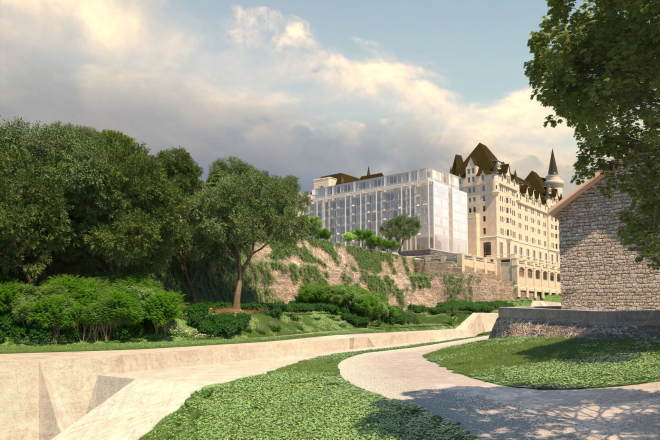Coffman: The Château Laurier Open House Presentation—What Was Said
In my last blog, I talked about the process at City Hall’s recent Château Laurier Open House. Today, I want to discuss the content.
First observation: after hearing Peter Clewes and Michael McClelland pontificating on the Gothic Revival and the Picturesque, and chiding the audience for not showing sufficiently European sophistication, I have never understood the term ‘mansplaining’ so well as I did that night.
Architect Peter Clewes spent a remarkable amount of time focusing on the virtues of the enclosed courtyard that will result from the addition of a fourth wing to the currently U-shaped building. I say ‘remarkable’ because this was a public audience of Ottawa residents, and that admirable courtyard will only benefit guests of the hotel. Even more importantly, having a beautiful courtyard is in no way dependent on having a bad addition.
The other theme that Clewes stressed repeatedly was that the addition was ‘deferential’ to the original building. One of the key points in defence of this was the lowering of the roof of the addition to the bottom of the roofline of the Château, allegedly leaving the distinctive silhouette of the Château intact. The problem is, this really only works in the elevation drawing – as soon as you’re in the real world and at ground level, the angle of view changes and the old roof starts to disappear from view. As you walk toward the Château through Major’s Hill Park, the gables and turrets sink lower and lower, like the flailing hands of a drowning man before he finally sinks below the surface for the last time.
The other argument for ‘deferential’ appeared to hinge on a touching, child-like faith that if the surface is clad in glass, the addition will essentially be transparent. Now, this may be true if the interior walls and floors are also glass, all the furniture and structural steel are removed, and everyone inside wears Harry Potter-like invisibility cloaks. Barring that, it’s just a new twist on the ‘if I close my eyes you can’t see me’ belief.
Let’s be clear. All this talk about being ‘deferential’ is nothing more than the architect’s search for a rationale, however feeble, for designing the kind of thing he always designs and sticking it onto the back of the Château Laurier. It’s the architectural equivalent of plausible deniability.
Michael McClelland, introduced as the heritage architect for the project, invoked the picturesque in support of the design. This surprised me, because a clear-headed understanding of the picturesque actually puts much of what is wrong with the design into sharp focus. What McClelland seemed to be arguing was that the picturesque valued variety, therefore a modern addition to a châteauesque building actually fits with the Château’s picturesque quality rather than violating it.
Wow! I used to think that design – especially picturesque design, which is famously complex and subtle – was hard! That it required skill, judgement, effort and care! Turns out that making something picturesque is just a matter of assembling a ragbag of forms that have nothing to do with each other: round + square + jagged + pointy = picturesque = beautiful. What suckers architects like John Nash and John Soane were, with their painstakingly crafted vistas and minutely balanced compositions.
Sarcasm aside, if you want to see stylistic variety that works, you don’t have to go far from home. Just glance across the canal, and see how the 20th-century, Beaux-Arts influenced Gothic Centre Block harmonizes with the Victorian Gothic East and West Blocks. Or walk along Wellington to the Bank of Canada, and see how 1970s Modernism can embrace and complement 1930s Classicism. Or go around the corner to see the 2004 addition to the Lord Elgin Hotel, and see what ‘deferential’ really looks like.
Then have another look at the proposed addition to the Château Laurier, and tell me if you think you’re seeing anything like same degree of care, thought and respect.
One stunningly tone-deaf moment summed up the whole Open House. ‘It’s alright’, declared Michael McClelland, ‘to be modern!’ Yes, obviously it’s alright to be modern – Ottawa has several brilliant modern buildings.
What’s not alright is to stick a grotesquely incongruous and intrusive addition onto an iconic heritage building at the heart of the national capital. Can they really not see the difference?
Read Heritage Ottawa's position statement on the proposed Château Laurier addition here.
Your Voice Matters!
The City of Ottawa is seeking public reaction to the proposed Château Laurier addition. Heritage Ottawa encourages all concerned citizens to review the proposal drawings and to
complete the city's Online Feedback Form before Friday, March 9
to make your views known.
Your actions can help to preserve the integrity of this important heritage building. Thank you.
________________________________________________________________
Peter Coffman is an architectural historian, Associate Professor of the History and Theory of Architecture (HTA) program at Carleton University, and Past President of the Society for the Study of Architecture in Canada. He blogs on architectural topics at https://carleton.ca/arthistory/hta-blog/
